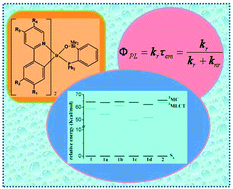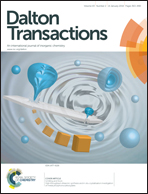A DFT/TDDFT study on the effect of CN substitution on color tuning and phosphorescence efficiency of a series of Ir(iii) complexes with phosphine-silanolate ligands†
Abstract
A DFT/TDDFT investigation was performed on the electronic structures, absorption and emission spectra, as well as the phosphorescence efficiency of [(ppy)2Ir(P^SiO)] (1) and the derivatives (1a, 1b, 1c and 1d) with CN-substitution at different positions in ppy ligands, as well as [(dfppy)2Ir(P^SiO)] (2) [where ppy = 2-phenylpyridine, dfppy = 2-(2,4-difluorophenyl)pyridine and (P^SiO) is an organosilanolate ancillary chelate]. The calculated results reveal that the introduction of CN leads to a significant red shift for 1a–1d in absorption spectra compared with that of 1. Moreover, the CN substitution at different positions on C^N ligands may be an efficient approach towards tuning emitting color. 1b, 1c, and 1d lead to a blue shift of emission spectra compared with 1, while an obvious red shift is observed for 1a. The high quantum yield of 1 (0.90) compared to 2 (0.59) is explained based on the S1–Tn splitting energies and energy gap between 3MLCT/π–π* and 3MC d–d states, and the evaluation of the radiative and nonradiative rate constants for all the complexes is also studied. The designed complexes 1a, 1c and 1d are expected to be potential phosphorescence emitters in OLEDs with high quantum efficiency.


 Please wait while we load your content...
Please wait while we load your content...